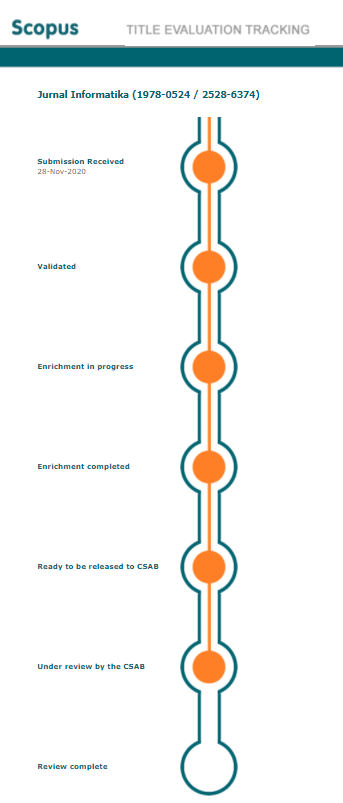Reusability ontology in business processes with similarity matching
Abstract
Full Text:
PDFReferences
Arwan, A., Sidiq, M., Priyambadha, B., Kristianto, H., & Sarno, R. (2013). Ontology and semantic matching for diabetic food recommendations. International Conference on Information Technology and Electrical Engineering: “Intelligent and Green Technologies for Sustainable Developmentâ€, ICITEE 2013. Doi.org/10.1109/ICITEED.2013.6676233.
Caldarola, E. G., Rinaldi, A. M., Picariello, A., (2015). An Approach to Ontology Integration for Ontology Reuse in Knowledge Based Digital Ecosystems. Conference: The 7th International ACM Conference on Management of computational and collective IntElligence in Digital EcoSystems (ACM MEDES'15). Doi.org/ 10.1145/2857218.2857219.
Fernández-López, M., Gómez-Pérez, A., & Suárez-Figueroa, M. C. (2013). Methodological guidelines for reusing general ontologies. Data and Knowledge Engineering. Doi.org/10.1016/j.datak.2013.03.006.
Tudorache, T., Nyulas, C., Noy, N. F., & Musen, M. A. (2013). WebProtege: A collaborative ontology editor and knowledge acquisition tool for the web. Semantic Web. Doi.org/10.3233/SW-2012-0057.
Jain, V., & Singh, M. (2013). Ontology Based Information Retrieval in Semantic Web: A Survey. International Journal of Information Technology and Computer Science. Doi.org/10.5815/ijitcs.2013.10.06.
Kunaefi, A., & Sarno, R. (2013). Ontology Mapping for Erp Business Process. Seminar Nasional Teknologi Informasi Dan Multimedia. Ojs.amikom.ac.id/index.php/semnasteknomedia/article/view/616.
Gandon, F. L. (2013). Ontologies in Computer Science. Ontology Theory, Management and Design. Doi.org/10.4018/978-1-61520-859-3.ch001.
Hayuhardhika, W., Putra, N., Sugiyanto, Sarno, R., & Sidiq, M. (2013). Weighted Ontology and weighted tree similarity algorithm for diagnosing Diabetes Mellitus. International Conference on Computer, Control, Informatics and Its Applications: “Recent Challenges in Computer, Control and Informaticsâ€, IC3INA. Doi.org/10.1109/IC3INA.2013.6819185.
D. Corsar and D. Sleeman, “Reusing JessTab rules in Protégé,†AI 2005 SI. Doi.org/10.1016/j.knosys.2005.11.010.
Hazber, M. A. G., Li, R., Gu, X., Xu, G., & Li, Y. (2015). Semantic SPARQL Query in a Relational Database Based on Ontology Construction. 2015 11th International Conference on Semantics, Knowledge and Grids (SKG). Doi.org/10.1109/SKG.2015.14.
Kurz, T., Schlegel, K., & Kosch, P. H. (2015). Enabling Access to Linked Media with SPARQL-MM. Doi.org/10.1145/2740908.2742914.
Meditskos, G., Dasiopoulou, S., & Kompatsiaris, I. (2016). MetaQ: A knowledge-driven framework for context-aware activity recognition combining SPARQL and OWL 2 activity patterns. Pervasive and Mobile Computing. Doi.org/10.1016/j.pmcj.2015.01.007.
Chiba, H., & Uchiyama, I. (2017). SPANG: a SPARQL client supporting generation and reuse of queries for distributed RDF databases. BMC Bioinformatics. Doi.org/10.1186/s12859-017-1531-1.
Xiang, Z., Courtot, M., Brinkman, R. R., Ruttenberg, A., & He, Y. (2010). OntoFox: web-based support for ontology reuse. BMC Research Notes. Doi.org/10.1186/1756-0500-3-175.
Didih Rizki Chandranegara, Riyanarto Sarno. (2016). Ontology Alignment using Combined Similarity Method and Matching Method. Informatics and Computing (ICIC), International Conference on. DOI:10.1109/IAC.2016.7905722.
Sun, Y. (2015). A Comparative Evaluation of String Similarity Metrics for Ontology Alignment. Journal of Information and Computational Science. Doi.org/10.12733/jics20105420.
Zarembo, I., Teilans, A., Rausis, A., & Buls, J. (2015). Assessment of name based algorithms for land administration ontology matching. Procedia Computer Science. Doi.org/10.1016/j.procs.2014.12.008.
Drebler, K., & Ngomo, A. C. N. (2017). On the efficient execution of bounded Jaro-Winkler distances. Semantic Web. Doi.org/10.3233/SW-150209.
Maree, M., & Belkhatir, M. (2015). Addressing semantic heterogeneity through multiple knowledge base assisted merging of domain-specific ontologies. Knowledge-Based Systems. Doi.org/10.1016/j.knosys.2014.10.001.
www.w3.org/standards/semanticweb/ontology.
Euzenat, J., Shavaiko, P. (2010). Ontology matching second Edition. Dl.acm.org/citation.cfm?id=1951780.
DOI: http://dx.doi.org/10.26555/jifo.v12i1.a7175
Refbacks
- There are currently no refbacks.
Copyright (c) 2019

This work is licensed under a Creative Commons Attribution-ShareAlike 4.0 International License.
____________________________________
JURNAL INFORMATIKA
ISSN :Â 1978-0524 (print) | 2528-6374 (online)

This work is licensed under a Creative Commons Attribution-ShareAlike 4.0 International License.






